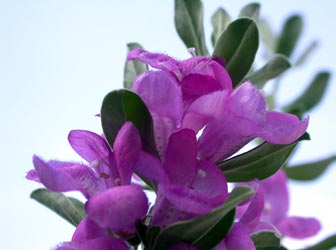Salvia is the largest kind of plants in the Minit Family with nearly 1000 species of shrubs annually. It is one of the several kinds that commonly referred to as sage.
This kind is distributed throughout the Old World and the Americas, with three distinct regions of variety:
Central and South America ; Central Asia and Mediterranean ; Eastern Asia (90 species).
Description:
Salvia species include annual, biennial, or perennial herbs, along with woody subshrubs. The stems are typically angled like other members of Lamiaceae. The leaves are typically entire, but sometimes toothed or pinnately divided. The flowering stems bear small bracts, dissimilar to the basal leaves in some species, the bracts are ornamental and showy.
The flowers are produced in clusters or panicles and generally produce a showy display with flower colors ranging from blue to red, with white and yellow less common. The calyx is normally tubular or bell-shaped, without bearded throats, and divided into two parts or lips, the upper lip entire or three-toothed, the lower two-cleft. The corollas are often paw shaped and are two-lipped. The upper lip is usually entire or three-toothed. The lower lip typically has two lobes. The stamens are reduced to two short structures with anthers two-celled, the upper cell fertile, and the lower imperfect. The flower styles are two-cleft. The fruits are smooth ovoid or oblong nutlets and in many species, they have a mucilaginous coating.
Many members of Salvia have hairs growing on the leaves, stems, and flowers, which help to reduce water loss in some species. Sometimes the hairs are glandular and secrete volatile oils that typically give a distinct aroma to the plant. When the hairs are rubbed or brushed, some of the oil-bearing cells are ruptured, releasing the oil. This often results in the plant being unattractive to grazing animals and some insects.
Staminal lever mechanism
The defining characteristic of the genus Salvia is the unusual pollination mechanism.
It is central to any investigation into the systematics, species radiation, or pollination biology of Salvia. It is instead of the typical four found in other members of the tribe Mentheae consists of two stamens and the two thecae on each stamen are separated by an elongate connective. It is the elongation of the connective that enables the formation of the lever mechanism.
It believed that the lever mechanism is a key factor in the speciation, adaptive radiation, and diversity of this large genus.

History
George Bentham was first to give a full monographic account of the genus in 1832-1836, and based his classifications on stamina morphology and it is still
the only comprehensive and global organization of the family.
He was less confident about his organization of Salvia. At that time, there were only 291 known Salvia species.

Subdivision:
Bentham eventually organized Salvia into twelve sections (originally fourteen), based on differences in scyphus , pappus, flag. These were placed into four subgenera that were generally divided into Old World and New World species.
His system is still the most widely studied classification of Salvia, however, more than 500 new species have been discovered since his work.
Other botanists have since offered modified versions of Bentham’s classification system while botanists in the last hundred years generally do not endorse Bentham’s system.
Salvia was monophyletic, meaning that all members of the genus evolved from one ancestor.
However, the immense variety in stamina structure, vegetative habit and floral morphology of the species within Salvia has opened the debate about its infrageneric classifications.
Selected species and their uses
Many species are used as herbs, as ornamental plants (usually for flower interest), and sometimes for their ornamental and aromatic foliage. The Plant List has 986 accepted species names.
Hybrids
Many inter specific hybrids occur naturally, with a relatively high degree of cross ability, but some of them have been intentional. A natural hybrid has given rise to a series of popular ornamentals.
Etymology
The name Salvia derives from the Latin severe. the verb related to sales , referring to the herb’s healing properties.
Pliny the Elder was the first author known to describe a plant called “Salvia” by the Romans, likely describing the type species of the genus Salvia, Salvia officinalis.
The common modern English name sage derives from Middle English sawge, which was borrowed from Old French sauge, and like the botanical name stems from Latin salvere. When used without modifiers, the name ‘sage’ generally refers to Salvia officinalis . however, it is used with modifiers to refer to any member of the genus. The ornamental species are commonly referred to by their genus name Salvia
